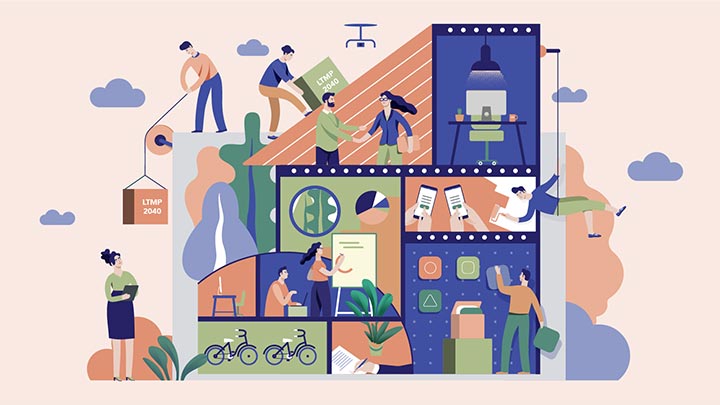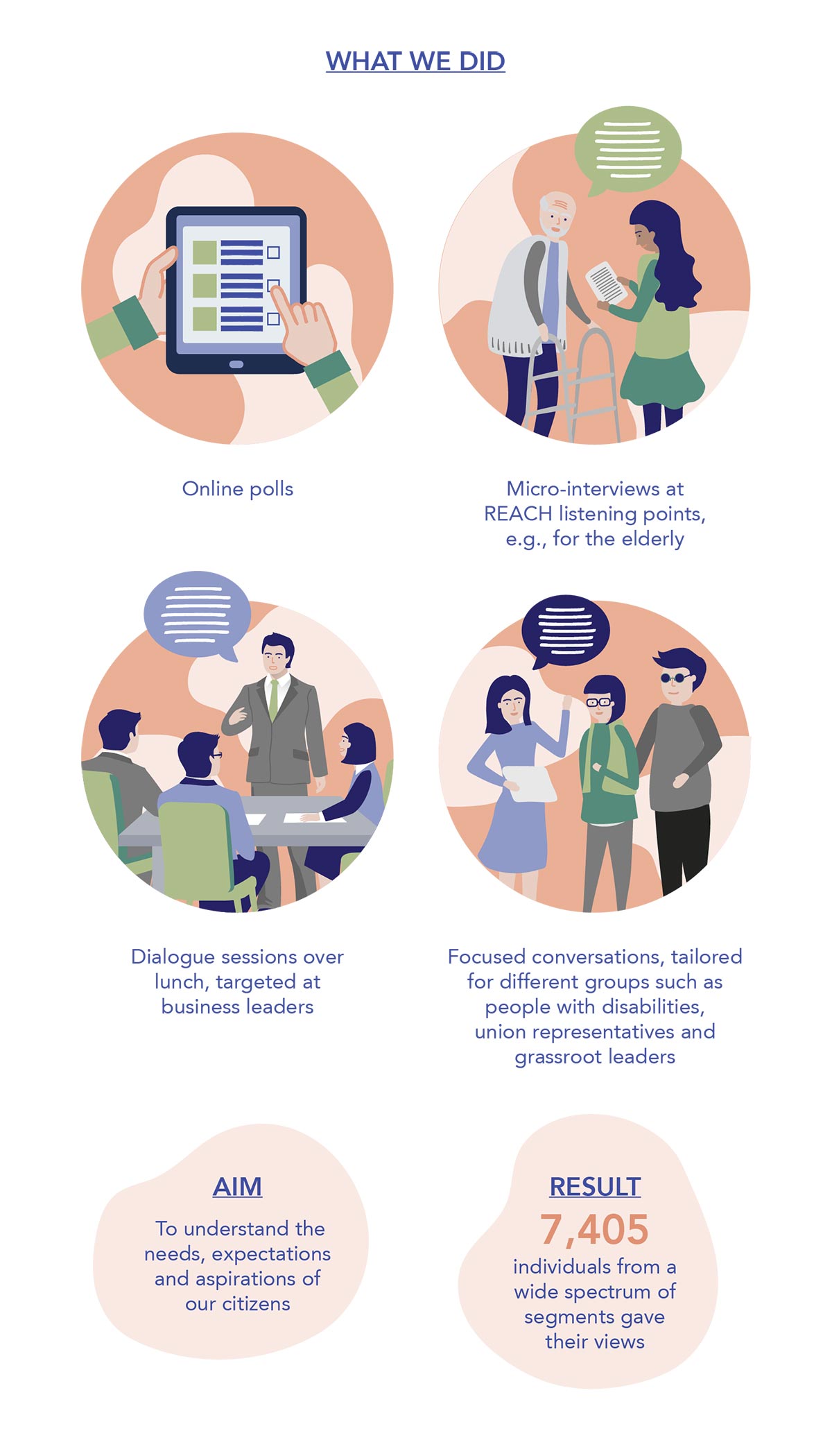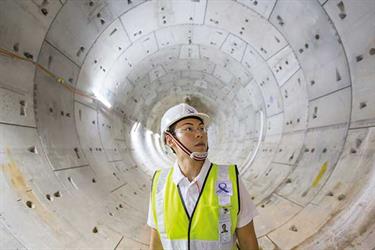3 Keys To Transforming Public Engagement – Tips From The LTA

Our organisations (and the Public Service as a whole) have many interconnected parts. To make a significant change, all the parts need to be willing and able to change. Otherwise, any change we try to make in one part of the system would face significant pushback from all the other parts.
I believe organisations need these three prerequisites to reinvent themselves.
Widespread transformation activity
If we were to look at how the Public Service has improved the lives of Singaporeans, we would see that the more successful initiatives are those with the most collaborations among public agencies. Examples include the Municipal Services Office and the Public Service Centre at Our Tampines Hub.
At the LTA, our transformation centres around being “Safer, Better, and more Cost-Effective” (SBC). To gather momentum for change, we created SBC project teams, now in their third year, and run by multidisciplinary agile teams advised by senior leaders. The projects cut across all parts of the LTA and each agile team has periodic check-ins with the Chief Executive. These highly visible and ambitious projects require significant collaboration across our organisation in order for the teams to get things done.
One SBC project focuses on enhancing the customer experience. Some of its highlights:
- Creating a new service vision for the LTA – refreshing a service vision is a crucial step in focusing and reinvigorating all leaders and staff in working towards the same goals;
- Extending our service partnership model to involve key partners such as our public transport operators (PTOs). One of many initiatives we are exploring with the PTOs is the viability of providing relevant data to help commuters make informed travel choices, such as displaying the operational status of lifts at MRT stations for the benefit of commuters with mobility challenges;
- Restructuring the LTA to instil empathy into our officers’ daily work and making service delivery the norm for all so that service excellence is not seen as an additional task, but as central to everyone’s core work; and
- Training management staff to be customer-experience specialists who will sustain a culture of continuous improvement in the LTA through their role-modelling and leadership in service transformation.
True believers in the mission
Fundamental beliefs or values influence the decisions we make each day – we are drawn to and do the things we do because we believe that they are important to us. Conversely, for the things that aren’t truly important to us, we typically stop doing them when it becomes inconvenient for us.
Read about Chief Executive Ngien Hoon Ping’s beliefs that guide him in leading transformation at the LTA.
That is why for us to transform the Public Service, all our officers and leaders need to truly believe in the benefits of transformation. That goes beyond understanding it at a cognitive level – if it were merely a knowledge gap issue that had been preventing us from radically transforming, then training alone would have solved the problem and spurred everyone into action. But there is a big difference between knowing and doing the right thing. Almost all of us know what we should be doing, but many of us don’t do it consistently.
At the organisation level, we can inculcate the culture of transformation in everyone by shifting organisational norms and expectations, and using meaningful KPIs. Individually, we can make it a daily ritual to remind ourselves the impact our work has on the lives of citizens.

Consider what is practised in the petroleum industry, where safety is paramount. At the start of each meeting, the most senior person in the room stands up and does a safety briefing. This happens regardless of where the meeting is held, be it at the refinery or in the CBD. This reinforces a culture of safety in the organisations, and keeps safety protocols fresh in everyone’s minds.
Imagine if the Public Service were to adopt this culture, starting every meeting with the chairperson reminding everyone in the room of why their work is important, how it impacts the lives of citizens, and the potential benefits to the community if we constantly improve our work.
Empathy for citizens and fellow officers
Empathy for our citizens and fellow officers allows us to appreciate the circumstance and choices driving their needs, expectations and aspirations. A technically-sound solution might not be well-received if there’s no understanding of our stakeholders.
Empathy is also the most important prerequisite for meaningful transformation – higher levels of empathy make the two other prerequisites easier to achieve. So how can we try to structure empathy into the workflow of our officers?

Most agencies have a division dedicated to engaging citizens. A typical workflow for the division would be:
- A citizen contacts the agency with an issue that needs to be resolved;
- The agency’s frontline division redirects the query to the appropriate internal division;
- The internal division works on it and submits a suggested response to the frontline division;
- The frontline division uses the response from the internal division in its reply to the citizen.
In an ideal case, the response (in step 4) resolves the citizen’s issue. If it doesn’t, we would have to go through these four steps again until the issue is resolved.
What if the internal divisions were equipped to engage citizens directly? To do this, we would need to multi-skill the frontline division staff to act as public engagement coaches to the internal division.
So instead of the typical model where internal divisions support a frontline division, we flip it around and have the dedicated frontline division staff support the previously internal divisions, which now engage citizens directly.
This would instil joint ownership and elicit a shared drive towards exercising empathy for citizens among staff.
The takeaway: What you can do
-
Share constant reminders of your values
Start every meeting with why everyone’s work is important, how it impacts citizens, and the potential benefits to the community of constantly improving our work.
-
Have multidisciplinary agile teams for transformation projects
These agile teams have a project sponsor role, usually a senior leader, to advise the team on the strategic direction and resources.
-
Equip internal divisions to engage citizens directly
Flip the script by having frontline-facing staff guide internal divisions to engage with citizens.
Engaging the public differently
The LTA’s public engagement for the Land Transport Master Plan (LTMP) 2040 is a great example of how these three prerequisites came together. The LTMP 2040 charts the future of Singapore’s land transport system over the next 21 years.

During the planning of the LTMP2040, Senior Minister of State (Transport) Dr Janil Puthucheary requested that all LTMP 2040 public engagement activities be planned, designed and run by LTA staff. This involved well over a hundred officers from across our organisation, almost all of whom held appointments in non-public facing roles (prerequisite one: widespread transformation activity).
Not unexpectedly, there was a significant level of doubt and uncertainty amongst the volunteered officers. With the help of the Civil Service College, we built up the officers’ capabilities in facilitation and public engagement (prerequisite three: empathy), and then set them loose in a series of internal focus group discussion (FGD) sessions with LTA staff as participants before the actual engagement sessions with members of the public.
Using LTA staff as table facilitators and scribes helped humanise our organisation to the FGD participants. After each session, the participants’ feedback showed that our trained LTA facilitators' openness and non-defensive approach reinforced the belief that the LTA was well-intentioned and truly interested in understanding their aspirations, needs and expectations for the future of land transport in Singapore.
As for the LTA table facilitators and scribes, I have found that their experience listening to and having crucial conversations with citizens have greatly renewed their commitment to the mission of the LTA (prequisite two: true believers in the mission). It served as a reminder that all of us are working for the betterment of our citizens, regardless of how far away from the frontline we are in the organisation.

About Dr Marcus Lee
Before joining the LTA, Dr Lee was the founding academic director of the Institute of Service Excellence at Singapore Management University, and the primary person responsible for the Customer Satisfaction Index of Singapore, the largest annual customer satisfaction survey in Singapore. At the LTA, he has been working with internal and external stakeholders to create a more collaborative, consultative, and customer-centric organisation.
Related stories:
- POSTED ON
Jun 7, 2019
- TEXT BY
Dr Marcus Lee
-
Cuppa

Making It Personal
-
nofilter
Tunnel Vision









